Fly Fishing with Doug Macnair: The Fly Reel - Fact & Fantasy: Part 4©
Fly Fishing with Doug Macnair: The Fly Reel - Fact & Fantasy: Part 4©
From his manuscript, Fly Fishing for the Rest of Us
For a sport that’s been around as long as fly fishing, the fly reel of the early Nineties remained fairly consistent with its forefathers. To be sure, the advent of space-age technology enabled a variety of new materials to be used in manufacturing components and drag mechanisms. Nevertheless, the basic design has remained constant: the direct drive fly reel has changed little. Now, dramatic change is afoot. The future is here and available today. At issue: will these innovations capture the minds and, perhaps more importantly, hearts of today’s fly fisher?
The Cassette Concept.
If you are new to fly fishing, someone no doubt told you to begin with a weight-forward floating line. I totally agree. However, I am always quick to add that this single line will not long suffice. To the contrary, it will take at least three lines to fish the water column effectively. (Fishing the water column effectively means catching fish.) And, as you by now know, I am of the opinion that the fly line is much more important than either the fly reel or, for that matter, the rod. Unfortunately, far too many experts - especially if they are standing behind the retail counter of a fly shop - sort of skip over this truth leaving the impression that one line will do it all.
Quite naturally, many retailers prefer to spin their way from fly lines to the latest innovations in rod technology and/or the close tolerances of a high-end fly reel. To some, this practice is no more than a legitimate ploy in effective retailing. Since most "experts" are retailers, selling you something is the way they make their living. The bigger the price tag, the more profit they make. This is not to suggest that the rod and reel you purchase should not be of quality -- it should be! But, quality today is not simply the product of how high the retail tag is set.
What bothers me most about this approach is the surprise that awaits many folks just a little way down the road -- once they master the fundamentals of the cast and learn two things: (1) fish are not usually on the surface and (2) wind is a big problem. Once armed with the knowledge that an intermediate sinker casts far better in the wind and fishes beneath the surface, buying a good one is not difficult; how to rig it, however, can be. With one reel, one spool, and two lines, there is an apparent problem: Only one line can be on the spool at any one time.
The simple, obvious and convenient solution is to buy another spool. That’s where the surprise might be waiting. If you purchased an Abel 3N (Ported) recently, the cost most probably ran in the vicinity of $625.00. Sure it’s a great reel, but your surprise is apt to be when you learn that a second spool will cost roughly $265.00, or about the same as a second fly reel of excellent quality. Short of a second spool, the only other practical way of changing lines is to buy a line spooler with a couple of spare boxes to enable off-loading one line from the reel, and loading the other. The Ancient Fish Gods, of course, will do their best to insure whatever line on the fly reel is the wrong line when you reach the water. Without a spooler and loop-to-loop connections, changing out lines isn’t fun. The only remaining way is the old hand stripping method. Switching by hand can be a nightmare, most especially if you happen to tangle the line. Just imagine the fun you will have when your partner catches a fish while doubled over with laughter as he or she thoroughly enjoys your dilemma. Nope -- switching lines at stream-side is not for me!
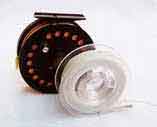 Not so long ago, Roberto L. Sacconi, owner of STH Reels had a better idea: Why not develop a system of reels featuring a "quick-switch" capability from one spool to another, but, without the high cost of traditional extra spools? The "Cassette" reel was born. Featuring a quick-switch cassette made of nearly indestructible clear polycarbonate. Switching a pre-loaded cassette of fly line and backing is no more difficult than removing the quick-release reel spool, unscrewing it and replacing the cassette with another. It takes all of about 30 - 45-seconds. Now, STH offers a "pop" version just in case unscrewing the spool takes too much time.
Not so long ago, Roberto L. Sacconi, owner of STH Reels had a better idea: Why not develop a system of reels featuring a "quick-switch" capability from one spool to another, but, without the high cost of traditional extra spools? The "Cassette" reel was born. Featuring a quick-switch cassette made of nearly indestructible clear polycarbonate. Switching a pre-loaded cassette of fly line and backing is no more difficult than removing the quick-release reel spool, unscrewing it and replacing the cassette with another. It takes all of about 30 - 45-seconds. Now, STH offers a "pop" version just in case unscrewing the spool takes too much time.
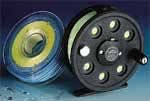 STH reels now range from the low to high end with some 8 models of the cassette reel, as well as three private label reels. Although the reels are made from different materials and have different drag systems and different prices, the cassettes are interchangeable, one to another, as long as the size remains constant. STH cassette reels begin with the new "IM-POP" cassette reel in size 2 (6/7/8-weight) at the base level of $79.00 and carrying a lifetime warranty. "IM" stands for "injection molded" using a special aluminum alloy. Even at this low price, STH has taken the pains to make it salt corrosion resistant.
STH reels now range from the low to high end with some 8 models of the cassette reel, as well as three private label reels. Although the reels are made from different materials and have different drag systems and different prices, the cassettes are interchangeable, one to another, as long as the size remains constant. STH cassette reels begin with the new "IM-POP" cassette reel in size 2 (6/7/8-weight) at the base level of $79.00 and carrying a lifetime warranty. "IM" stands for "injection molded" using a special aluminum alloy. Even at this low price, STH has taken the pains to make it salt corrosion resistant.
There are some, of course, who reject the cassette concept and, admittedly, it is at variance to traditional thinking. However, other than sitting down by the side of the stream and stripping off the fly line by hand, and then replacing it with another, I know of no other way to switch lines unless it to switch loaded spools. Unfortunately, adding extra spools can quickly become expensive. Why, I have wondered, do fly fishers not see the efficiency of the cassette technique. Now, I understand -- to some, going fly fishing is something like going on safari. On safari, the gun bearer carries the gun; in fly fishing, the "reel bearer" carries the reels. Must be nice …
If you are a member of the clan I call, "The Rest of Us," and cannot afford a "reel bearer," much less one of every reel, the cassette system offers a great alternative for a lot less money. The last time I checked, extra cassettes run around $10.00.
The Turbine.
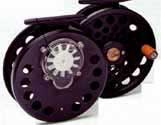 Not content to rest on the laurels of his cassette design, Roberto L. Sacconi’s latest innovation is the Turbine fly reel. Look closely and you will find no cork or Teflon disc-drag, no knob to turn, nothing to adjust. Instead, underneath a metal "bump" on the reel’s backside, there is a sealed well holding a turbine impeller immersed in a special multi-viscosity fluid. (The Turbine reel depicted here is equipped with a clear cover so that you can see it.) The idea rests on the physics principle of action/reaction. Simply stated, the faster the run of the fish, the greater the drag imposed. As the fish slows, the drag is released. That’s it! That’s the drag. Nothing to adjust; no knobs to turn; nothing to maintain.
Not content to rest on the laurels of his cassette design, Roberto L. Sacconi’s latest innovation is the Turbine fly reel. Look closely and you will find no cork or Teflon disc-drag, no knob to turn, nothing to adjust. Instead, underneath a metal "bump" on the reel’s backside, there is a sealed well holding a turbine impeller immersed in a special multi-viscosity fluid. (The Turbine reel depicted here is equipped with a clear cover so that you can see it.) The idea rests on the physics principle of action/reaction. Simply stated, the faster the run of the fish, the greater the drag imposed. As the fish slows, the drag is released. That’s it! That’s the drag. Nothing to adjust; no knobs to turn; nothing to maintain.
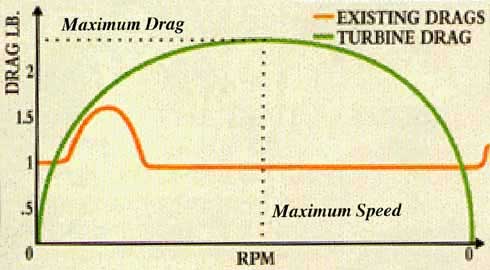
Does it work? You bet! I had the privilege of evaluating a Turbine and quite truthfully, I like it. The Turbine is a tippet saver if ever there was one. No internal friction is produced, either at startup or during the fish's run. STH and Cortland use this chart to contrast the performance of a typical fly reel against the Turbine. (sthturb2.gif) I think the chart speaks for itself as long as you remember the smooth oval line represents the Turbine while straight line with the "hump" on the left typifies the conventional fly reel. The Turbine is available from both STH and Cortland. The Cortland version is machined from solid aluminum and is called the Vista Turbine; the STH versions include the injection-molded IM Turbine and the machined STH POP Turbine featuring the cassette design.
Anti-Reverse Reels.
There is a time on the water when you might want to consider an alternative to the direct drive reel. Use a direct drive reel, hang a big fish that runs hard, and note the spinning spool on your reel. Stick your little pinkie into that spinning vortex and I assure you blood and gore await. As they used to say, "Once burned is once learned."
In the aftermath of stupidity -- after the damaged fingers are bandaged and you’ve swallowed a couple of pain pills -- just what are the alternatives? (Don’t forget to say "thanks" to the smiling doctor now fingering your greenbacks.) The alternative is the anti-reverse fly reel.
 Blue water fly fishing is a perfect example of when you might want to consider the anti-reverse reel. The Billy Pate Marlin depicted here, is illustrative of a high end, high quality anti-reverse reel. It works exactly like most bait or spinning reels, when the fish hits, the handle of the reel remains stationary as the spool spins releasing line against the drag. The drag adjustment knob is located on the handle side of the spool and works very much like the star drag on bait-casting reels. Turn it one way to lighten the drag, turn it the other way to tighten the drag. This setup enables easy adjustment without the rod ever having to leave your fighting hand. Nothing could be simpler.
Blue water fly fishing is a perfect example of when you might want to consider the anti-reverse reel. The Billy Pate Marlin depicted here, is illustrative of a high end, high quality anti-reverse reel. It works exactly like most bait or spinning reels, when the fish hits, the handle of the reel remains stationary as the spool spins releasing line against the drag. The drag adjustment knob is located on the handle side of the spool and works very much like the star drag on bait-casting reels. Turn it one way to lighten the drag, turn it the other way to tighten the drag. This setup enables easy adjustment without the rod ever having to leave your fighting hand. Nothing could be simpler.
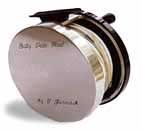 When you stop to think about a tarpon, marlin, or sailfish being at the end of your line, an anti-reverse reel makes sense. As you might imagine, a blue water reel, such as the Marlin, is built to accommodate heavy, strong, and long-running fish. The Marlin, for example, carries close to 400 yards of 30-pound backing. The Billy Pate series has earned accolades under rough and tough conditions and holds some twenty world records. Just think -- no bleeding fingers or skinned knuckles as the spool turns!
When you stop to think about a tarpon, marlin, or sailfish being at the end of your line, an anti-reverse reel makes sense. As you might imagine, a blue water reel, such as the Marlin, is built to accommodate heavy, strong, and long-running fish. The Marlin, for example, carries close to 400 yards of 30-pound backing. The Billy Pate series has earned accolades under rough and tough conditions and holds some twenty world records. Just think -- no bleeding fingers or skinned knuckles as the spool turns!
By the way, some reels are user friendly to either the right or left hand, others, such as the Billy Pate reels by Ted Juracisk, are not. Knowing this, decide which hand will do the winding before you buy; otherwise, it is likely to require a trip back to the factory.
The Large-Arbor Reel.
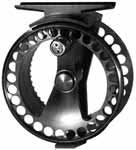 The latest rage in fly fishing is the "large-arbor" reel. As the name implies, the arbor is large, as depicted here by the Waterworks’ ULA. The traditional fly reel, as you know, utilizes a direct drive. That means one revolution of the spool releases or retrieves a length of line equal to the circumference of the spool’s diameter -- at that point. Said another way, a full spool will release more line in one turn of the spool than the same will when way down into the backing. The consequence? As the circumference of the spooled line grows smaller, the resistance against releasing the line increases. In other words, the drag does not remain constant regardless of the setting. This is why I teach folks to use a minimum drag setting -- just enough to prevent the spool from spinning when stripping line.
The latest rage in fly fishing is the "large-arbor" reel. As the name implies, the arbor is large, as depicted here by the Waterworks’ ULA. The traditional fly reel, as you know, utilizes a direct drive. That means one revolution of the spool releases or retrieves a length of line equal to the circumference of the spool’s diameter -- at that point. Said another way, a full spool will release more line in one turn of the spool than the same will when way down into the backing. The consequence? As the circumference of the spooled line grows smaller, the resistance against releasing the line increases. In other words, the drag does not remain constant regardless of the setting. This is why I teach folks to use a minimum drag setting -- just enough to prevent the spool from spinning when stripping line.
Loop, the Swedish reel manufacturer, pioneered the large arbor reel to (1) alleviate the problem of drag consistency, (2) minimize startup inertia, and (3) increase retrieval speed. The large arbor, offset as it is from the reel’s spindle, quite naturally retrieves or releases more line in a single turn than the traditional fly reel. The trouble is, to carry the same amount of backing as a conventional fly reel, the large-arbor has to have a greater diameter and a spool configured with a wide and shallow line cavity. If it doesn’t, the backing capacity is sacrificed.
Like most things designed and developed to solve problems, the large-arbor reel isn’t a perfect solution. There is a practical limit to the width of the spool. In fact, the wider the spool, the more difficult it becomes to lay the line smoothly and equally during the retrieval process, especially in a battle with friend fish. Keep in mind, these gadgets do not have a level-wind mechanism. I have not yet had the opportunity to fish a large arbor reel, so beyond the design’s theoretical strengths and weaknesses, I cannot comment.
Many manufacturers have jumped aboard the large-arbor bandwagon. Look for names such as Abel, Bauer, Bringsen, Cabela’s (HPLA), Cortland, Fin-Nor, Fly Logic, Galvan, Islander, G. Loomis, L.L. Bean, Phos, and Stenzel. I am sure there will be more to come. Expect to find spending more money for a large-arbor reels than one of their brethren. It is also quite clear that some large-arbor reels do little other than reduce the amount of available backing. It seems to me little is accomplished by switching-out a deeper spool with a shallow one of the same size other than to save a few dollar bills in backing. Personally, I prefer the backing, any day! On the other hand, the true large-arbor reels such as those produced by Loop, Cortland, The Waterworks, and Sage (a reel version licensed by the Waterworks) may prove to be just the ticket.
What to Buy?
Sum everything that's been said, and it should be apparent that fly reel arena is "chock-full" of quality contenders. Those covered in this overview are, in my opinion, great values -- some a little better value for the dollars required for others. But remember two things: (1) what's said is my opinion only, and (2) always consider the environment and purpose the reel is intended to match. My advice? In short, fishing the salt routinely is the supreme test of any reel, and if this is the course you intend to pursue, buy a reel built for the salt. On the other hand, ever-so-many good reels can take-on the salt for short periods, just as long as the owner-operator performs the required "after-operation" maintenance.
Think of it this way: First, define the fishing environment for the reel, then consider the contenders in terms of RAM data. I find this term meaningful: RAM stands for Reliability, Availability, and Maintainability. Obviously, the term, "reliability," simply means if the reel quits, forget fishing. How can a reel quit? A reel quits when a screw is lost or a drag begins to burn. The term, "availability," usually requires a little more explanation. Suppose you need to switch the retrieve from one hand to the other, and you cannot -- that’s availability -- the reel works, but not the way it needs to work, for you. If you must send the reel to the factory for repair or modification, it really is not available when you spy that trophy red finning 60-feet away. The term, "maintainability," is fairly obvious in its meaning -- who wants to spend endless hours washing, cleaning, and lubricating reels? The less maintenance required, the better!
So much for the fly reel -- every year seems to bring new ones to an already crowded field. In the end, the consumer benefits from the increased competition. Competition brings higher quality for less money -- except for those interested in fishing a name. Inquire before you buy. Take your time and compare the specifications and warranties for any of the reels discussed or the many others in your catalog. It is, after all, impossible for any writer to fairly evaluate and test one of everything.
Next: The discussion changes. Next up is the beginning of what I call, "Rigging for Combat." I think you will enjoy my comments on America’s favorite, the largemouth bass, and my favorite, the smallmouth, along with suggestions on America’s classical favorite -- trout, et al. The Salt will be treated separately. Stay tuned! God Bless.
© Copyright: Douglas G. Macnair, 2001.
|